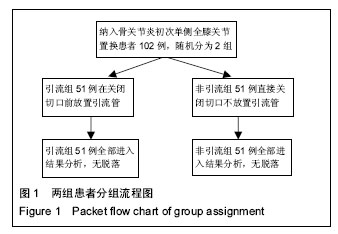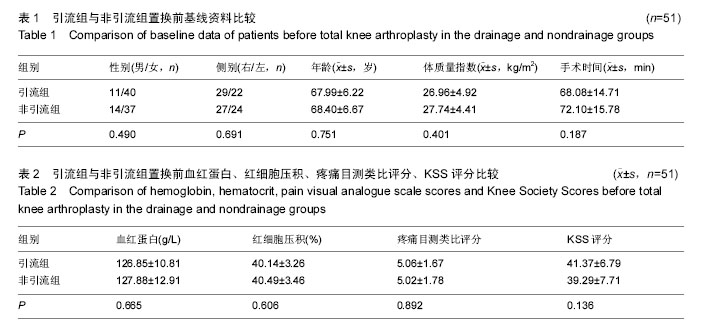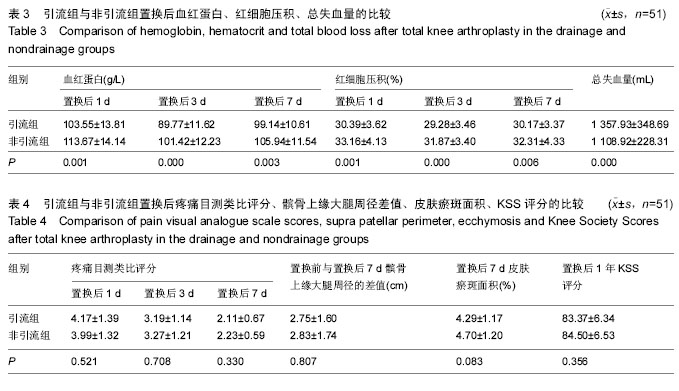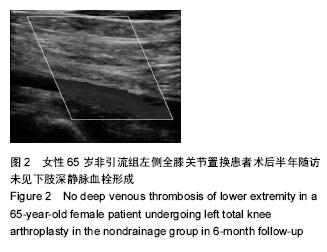| [1] 申延清,刘凤霞,曹红,等.膝骨关节炎患者的临床表现及相关影响因素[J].中国组织工程研究与临床康复,2011, 15(9): 1643-1646.[2] 郭泰,宣雯霞,毕树雄,等.膝骨关节炎的治疗进展[J].中国药物与临床,2014,14(3):330-332. [3] Lawrence RC, Felson DT, Helmick CG,et al. Estimates of the prevalence of arthritis and other rheumatic conditions in the United States. Part II. Arthritis Rheum. 2008;58(1):26-35.[4] 裴福兴.中国髋、膝关节置换的现状及展望[J].中国骨与关节杂志,2012,1(1):4-8.[5] Ebert JR,Munsie C,Joss B, et al.Guidelines for the early restoration of active knee flexion after total knee arthroplasty: Implications for rehabilitation and early intervention.Arch Phys Med Rehabil. 2014;95(6): 1135-1140.[6] Waugh TR, Stinchfield FE. Suction drainage of orthopaedic wounds. J Bone Joint Surg.1961; 43(7): 936-946.[7] Kim YH, Cho SH, Kim RS.Drainage versus nondrainage in simultaneous bilateral total knee arthroplasties. Clin Orthop Relat Res. 1998;347(2):188-193.[8] Li C,Nijat A,Askar M. No clear advantage to use of wound drains after unilateral total knee arthroplasty: a prospective randomized, controlled trial. J Arthroplasty. 2011;26(4):519-522.[9] 张晓敏,李国庆,马骏,等.初次人工全膝关节置换术后放置引流疗效及安全性荟萃分析[J].中华医学杂志,2014,94 (29):2282-2285.[10] Esler CN, Blakeway C, Fiddian NJ. The use of a closed suction drainage in total knee arthroplasty. A prospective, randomised study. J Bone Joint Surg(Br). 2003;85(2): 215-217.[11] Dora C, Campe A, Mengiardi B, et al. Simplified wound care and earlier wound recovery without closed suction drainage in elective total hip arthroplasty. A prospective randomized trial in 100 operations. Arch Orthop Trauma Surg. 2007;127(9): 919-923.[12] 范彧,金今,孙志坚,等.全膝关节置换术中止血带不同使用方式的近期作用评价[J].中国医刊,2013,48(4):28-32.[13] 王世和.人工膝关节置换:技术发展与临床应用及评价[J].中国组织工程研究与临床康复,2010,14(35): 6587-6590.[14] Gross JB. Estimating allowable blood loss: corrected for dilution. Anesthesiolog.1983;58(3):277-280.[15] Nadler SB, Hidalgo JU, Bloch T. Prediction of blood volume in normal human adults. Surgery. 1962;51: 224-232.[16] Brokelman RB, van Loon CJ, Boog GJ. Surgeon satisfaction agreement after total knee arthroplasty using a visual analogue scale: a single surgeon series. Arch Orthop Trauma Surg. 2008;128(3):255-259.[17] Insall JN, Dorr LD, Scott RD, et al. Rationale of The Knee Society Clinical Rating System. Clin Orthop.1989; (248):13-14.[18] Liow RYL, Walker K, Wajid MA, et al.The reliability of the American Knee Society Score.Acta Orthop Scand. 2000;71(6):603-608.[19] Saksena J, Platts AD, Dowd GS. Recurrent haemarthrosis following total knee replacement. Knee. 2010;17(1):7-14.[20] 董盼锋,陈跃平,康杰,等.人工膝关节置换的引流效应[J].中国组织工程研究,2014,18(17):2649-2654.[21] Jung WH, Chun CW, Lee JH, et al. No difference in total blood loss, haemoglobin and haematocrit between continues and intermittent wound drainage after total knee arthroplasty. Knee Surg Sports Traumatol Arthrosc. 2013;21(12):2831-2836.[22] Callaghan JJ, O’Rourke MR, Liu SS. Blood management: issues and options. J Arthroplasty. 2005;20(4Suppl 2):51-54.[23] Cid J, Lozano M. Tranexamic acid reducdes allogeneic red cell transfusions in patients undergoing total knee arthroplasty: results of a meta-analysis of randomized controlled trials. Transfusion. 2005;45(8):1302-1307.[24] White RH, Henderson MC. Risk factors for venous thromboembolism after total hip and knee replacement surgery. Curr Opin Pulm Med. 2002; 8(5):365-371.[25] 昝鹏飞,杨勇,李国东,等.止血带在全膝关节置换术中的应用研究进展[J].国际骨科学杂志,2014,35(6): 385-386.[26] Molt M, Harsten A, Toksvig-Larsen S, et al. The effect of tourniquet use on fixation quality in cemented total knee arthroplasty a prospective randomized clinical controlled RSA trial. Knee. 2014;21(2):396-401.[27] 胡旭栋,周宗科,裴福兴,等.全膝关节置换围手术期氨甲环酸不同使用方法的有效性和安全性[J].中华骨科杂志, 2014, 34(6):599-604.[28] 何洁,张峡,易德坤,等.关于人工膝关节置换术后伤口引流管留置与管理方案的临床进展[J].中国矫形外科杂志, 2016,24(1):58-60.[29] 张纪,张洪.人工膝关节置换术后留置引流与否的对比研究[J].中华外科杂志,2011,49(12):1119-1122. [30] Chandratreya A, Giannikas K, Livesley P. To drain or not drain: literature versus practice. J R Coll Surg Edinb. 1998;43(6):404-406.[31] Kosins AM, Scholz T, Cetinkaya M, et al. Evidence-based value of subcutaneous surgical wound drainage: The largest systematic review and meta-analysis. Plast Reconstr Surg. 2013;132(2): 443-450.[32] Demirkale I, Tecimel O, Sesen H, et al. Nondrainage decreases blood transfusion need and infection rate in bilateral total knee arthroplasty. J Arthroplasty. 2014; 29(5):993-997.[33] Al-Zahid S, Davies AP. Closed suction drains, reinfusion drains or no drains in primary total knee replacement? Ann R Coll Surg Engl. 2012;94(5): 347-350.[34] 陶坤,吴海山,李晓华,等.闭式引流在全膝关节置换术中的作用评价[J].中华外科杂志,2006,44(16):1111-1114.[35] Holt BT, Parks NL, Engh GA, et al. Comparison of closed-suction drainage and no drainage after primary total knee arthroplasty. Orthopedics. 1997;20(12): 1121-1125.[36] Lin J,Fan Y,Chang X, et al.[Comparative study of one stage bilateral total knee arthroplasty with or without drainage]. Zhonghua Yi Xue Za Zhi. 2009;89(21): 1480-1483.[37] Praker MJ, Robetrs CP, Hay D. Closed suction drainage for hip and knee arthroplasty . A meta-analysis. J Bone Joint Surg(Am). 2004;86(11): 1146-1152.[38] Zhang QD, Guo WS, Zhang Q, et al. Comparison between closed suction drainage and nondrainage in total knee arthroplasty: a meta-analysis. J Arthroplasty. 2011;26(8):1265-1272.[39] Kudrna J. New oral anticoagulants after total knee arthroplasty: clinical considerations for orthopaedic surgeons. Curr Orthop Pract. 2013;24(4):424-432.[40] 高娜,石跃.一期双侧人工全膝关节置换术后放置引流对患者康复进程的影响[J].中华现代护理杂,2011,17(35): 4314-4315.[41] Wang G, Wang D, Wang B, et al. Efficacy and safety evaluation of intra-articular injection of tranexamic acid in total knee arthroplasty operation with temporarily drainage close. Int J Clin Exp Med. 2015;8(8): 14328-14334.[42] Seo JG, Lee SA, Moon YW, et al. Infrapatellar fat pad preservation reduces wound complications after minimally invasive total knee arthroplasty. Arch Orthop Trauma Surg. 2015;135(8):1157-1162.[43] Kuo SJ, Wang FS, Wang CJ, et al. Effects of Computer Navigation versus Conventional Total Knee Arthroplasty on Endothelial Damage Marker Levels: A Prospective Comparative Study. PLoS One. 2015; 10(5): e0126663. |
.jpg)




.jpg)